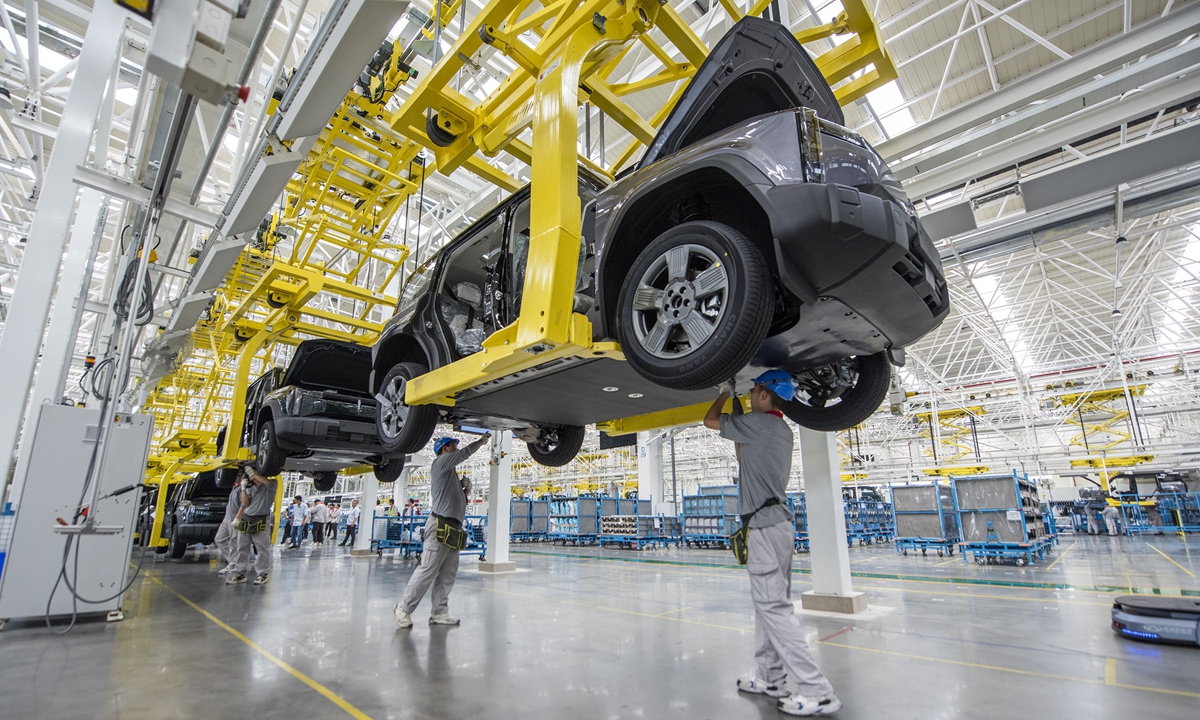
Workers assemble new-energy vehicles in Chery's assembly workshop in Wuhu city, East China's Anhui Province, on May 23, 2024. In recent years, Wuhu has prioritized this industry in its green transformation and industrial upgrading, drawing more than 300 companies across industries. Photo: VCG
The first-half value-added of industrial enterprises above the designated size grew by 6 percent year-on-year, according to data from the National Bureau of Statistics (NBS) on Monday, reflecting a strong start to China's industrial performance this year and demonstrating a sustained trend of recovery, despite facing multiple challenges.
"Designated size" refers to industrial entities with an annual main business income of 20 million yuan ($2.75 million) or more.
Experts said that the latest data illustrate the increasing importance of Chinese manufacturing, particularly in high-end manufacturing, under the government's call to promote new quality productive forces. This trend underscores the resilience of China's supply chains and the strong global demand for Chinese manufactured goods.
Meanwhile, challenges persist including those from the intensified protectionism of the West, experts said, calling for more efforts to secure growth.
The first-half industrial output maintained the rapid pace that began in the fourth quarter of last year, Tang Weiwei, an official of the NBS, said on Monday.
Exports of industrial products, and the development pace of high-end, intelligent and green manufacturing accelerated during this period, Tang said, indicating the drivers of the growth.
For example, the new-energy vehicle industry maintained rapid growth, with production up by 34.3 percent year-on-year, according to the NBS official. The photovoltaic industry also showed a good growth trend.
The growth of these booming industries, the pillars of the nation's advanced manufacturing capabilities, provides evidence of China's competitive industrial and supply chains, despite decoupling attempts by certain countries targeting China, experts said.
In US dollar terms, exports of machinery and electronic products grew year-on-year during each month of the second quarter, Gao Shiwang, spokesperson for the China Chamber of Commerce for Import and Export of Machinery and Electronic Products, told the Global Times on Monday.
In June alone, exports reached a nearly 14-month high, with improved external demand and international restocking efforts providing significant support, Gao said.
Moreover, the recovery in exports by traditional industries has been bolstered by cyclical upturns, while the introduction of new technologies such as artificial intelligence has stimulated demand in certain sectors, according to Gao, noting that "the resilience and integrity of China's machinery and electronic industry supply chains contributed to stabilizing and enhancing international market shares for its products."
China's increasingly advanced manufacturing capabilities, as highlighted by the strong industrial output, show that China is making a successful industrial transformation and upgrade, according to experts.
Value-added products such as the "new three" -- new-energy vehicles, lithium-ion batteries and photovoltaic products -- have become an important part of the trade sector, driving economic growth, Li Chang'an, a professor at the Academy of China Open Economy Studies at the University of International Business and Economics, told the Global Times on Monday, responding to the good industrial performance.
"China's competitive manufacturing capability also shows that it is unrealistic for certain countries to decouple from China," Li said.
China's booming manufacturing power is backed up by facilitation of industry upgrading under the government's call for the development of new quality productive forces, with innovation and green development being at the core, Hu Qimu, deputy secretary-general of the Digital-Real Economies Integration Forum 50, told the Global Times on Monday.
Challenges remain daunting, including insufficient domestic demand, extreme weather, and complex international situations such as trade protectionism and geopolitical conflicts, which continue to undermine global economic vitality, officials and experts said.
In the face of the external environment, which remains unfriendly and challenging, marked by rising protectionism from the US-led West targeting China, Hu said that it is important for China to unleash domestic demand while diversifying opportunities with a wide range of economies, including those involved in the Belt and Road Initiative, to unlock more growth potential.
While the industrial economy had a smooth and positive first half, the current external environment is complex and severe, and domestic effective demand remains insufficient, Tang said.
At the next stage, efforts will be made to expand effective investment in manufacturing, accelerate the formation of new quality productive forces, and continuously consolidate and enhance the positive trend of the industrial economy's recovery, said Tang.




